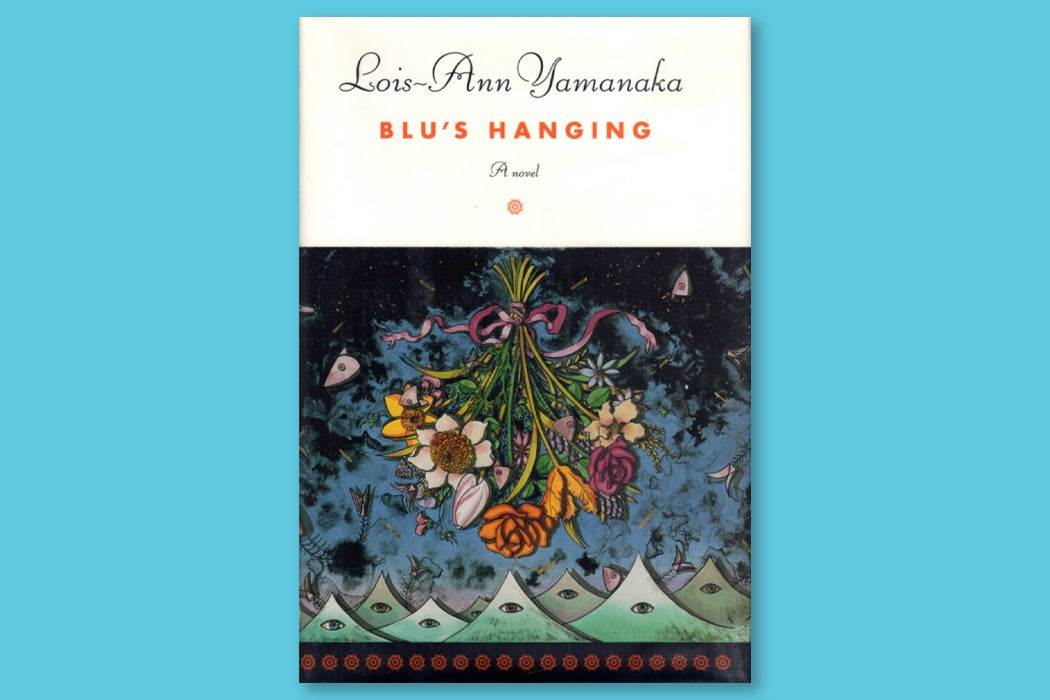Twenty-five years later, a 1998 Association for Asian American Studies (AAAS) book prize decision remains polarizing among Asian American critics.
The association’s decision to honor Lois-Ann Yamanaka’s novel Blu’s Hanging, published a year earlier, sparked opposition “so overwhelming that the membership of the association voted to rescind the award, after which the entire board of the AAAS, save for its graduate student representative, resigned,” scholar Cynthia Wu recounts.
Set in Hawai‘i, Blu’s Hanging follows teenager Ivah Ogata, whose siblings are struggling after their mother dies. Eventually, Ivah, her brother, Blu, and her sister, Maisie, find support from a cousin nicknamed Big Sis, who acts as a surrogate parent with the help of her housemate (and coincidentally one of Ivah’s teachers), Sandi Ito.
However, the plot of the novel also features mounting tension between the Ogata family and their next-door neighbors, the Reyes family. “Uncle Paolo,” the only adult in the Reyes household, is revealed as a pedophilic predator who abuses his nieces. He eventually rapes the young Blu as well.
“A large part of the outrage against the portrayals of Filipino sexual deviance in Blu’s Hanging stemmed from the fact that Yamanaka had—at that point—already been taken to task for similar themes,” explains Wu, pointing to a poem published in 1993 that “could be read as an indictment of Japanese racism against Filipinos, but…risks reproducing and exaggerating some of the most pernicious stereotypes about Filipino men” as well.
Wu argues that the inequality between Japanese and Filipino communities in Hawai‘i is intertwined with depictions of queerness in Blu’s Hanging, where “any illusion of queer transgression is dependent upon a deeply entrenched, ethnically specific class hierarchy.”
For example, she describes the intimacy between Big Sis and Sandi—which is implied to be a lesbian relationship—as “pleasing” and a “welcoming respite” in an otherwise bleak story.
But, noting that the two women are able to cohabitate only because of their roles as trainee teachers, Wu suggests that their relationship “actually reproduces and maintains structures of both heterosexual and East Asian ethnic/class privilege through the idealized domesticity they present.”
“It is the very fact of their ethnic and settler identity—and the cultural and economic capital accompanying it—that allows these two women to exercise their refusal of heterosexual pairings with men,” she writes, adding that their relationship falls “within the hegemonically sanctioned maintenance of a diametrically gendered, child-rearing household” as they care for the Ogata children.
Provocatively, Wu observes that the scene where “the ethnic-racial hierarchy in Hawai‘i actually does get challenged” is centered on the controversial character of Uncle Paolo, the rapist, who drunkenly cries out in an outburst: “Fuck, Japs for think they mo’ betta than everybody else, fuckas. Especially the Filipinos. Fuck, everybody for spit on Filipinos, shit.”
Weekly Newsletter
Wu writes that it is “obvious that this critique of East Asian racism against Filipinos becomes invalidated by the fact that it is spoken by an inebriated child molester.” All the same, she finds it troublesome that the book’s “most maligned character” is the one who calls out East Asian privilege.
“It appears that in the local Japanese collective imagination, an appeal to redress the past and present social iniquities suffered by Filipinos becomes equated with the sexual violation of vulnerable, unyielding, childlike Japanese bodies,” she adds. “That Paolo rapes Blu shortly after this tirade signifies in troubling ways the inevitable ideological violence of making the sexually inflected subjugation of Filipinos legible.”
As such, the novel’s “seemingly progressive queer politics…appears to rest upon and reinforce East Asian ethnic privilege in Hawai‘i.”







